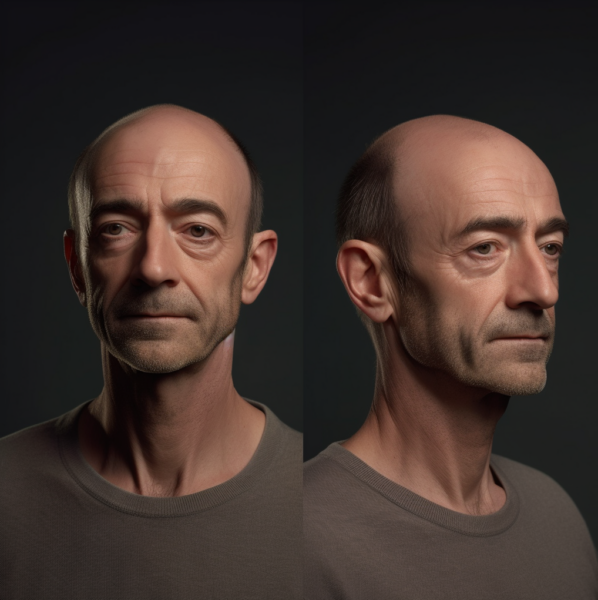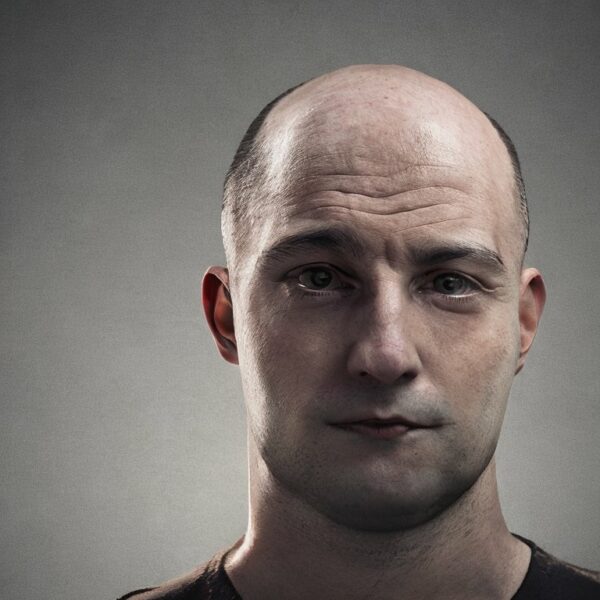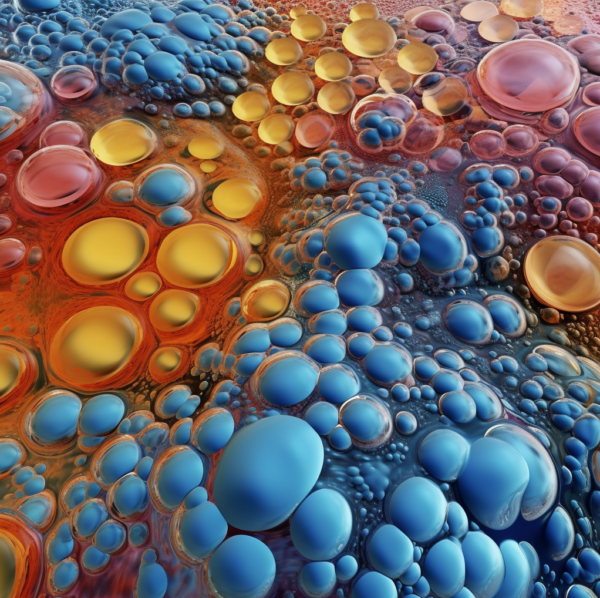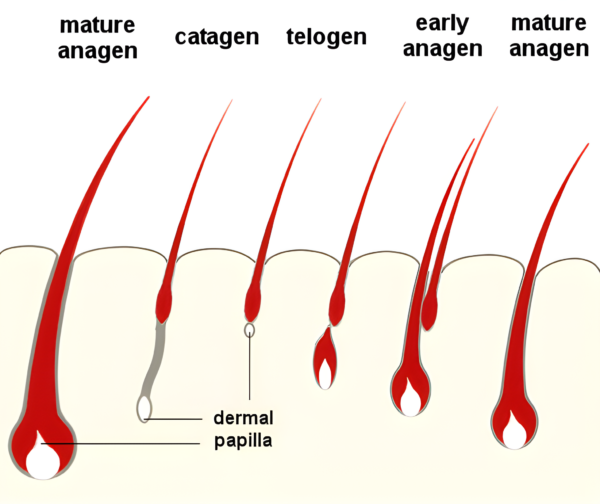Pattern hair loss, or Androgenetic Alopecia (AGA), has long been misunderstood as a purely genetic and hormonal issue. However, emerging research shows that microinflammation plays a pivotal role in the progression of this common condition. While AGA is traditionally regarded as a non-inflammatory and non-scarring form of hair loss, histological examinations have revealed inflammatory patterns closely associated with the condition.
The Inflammatory Connection: Early research identified significant associations between the severity of inflammatory infiltration around hair follicles and the extent of hair miniaturization. A study involving 17 women with AGA and 5 normal controls revealed that inflammation was correlated with hair follicle shrinkage. Furthermore, the study showed that 87.9% of the AGA group had perifollicular lymphocytic infiltration, a sign of inflammation. Notably, this rate was comparable to another form of hair loss, Alopecia Areata (AA), which is known to be inflammatory. These findings suggest that microinflammation is not exclusive to traditionally inflammatory hair loss conditions and can be present in AGA as well.
Trichophages and Hair Growth: One of the crucial discoveries in understanding microinflammation in AGA is the role of Trichophages. These are specialized macrophages found near hair follicles. During the hair’s resting phase, Trichophages produce a cytokine called Oncostatin M (OSM). OSM secreted by the trichophage cells, binds to its receptor on hair follicle stem cells (HFSCs), which leads to the phosphorylation of STAT5 in HFSCs. This, in turn, inhibits stem cell activation, prolonging the resting phase and subsequently delaying hair growth. This mechanism is believed to contribute to the hair thinning and loss observed in AGA.
Mast Cells and Fibroblast Activation: Further supporting the connection between microinflammation and AGA, a study by Jaworsky examined the scalps of individuals with progressive alopecia. The study found that in areas of hair loss, there was a thickening of the outer follicular sheath which was associated with mast cell degranulation and fibroblast activation. These observations indicate that inflammatory processes are actively involved in the structural changes seen in AGA-affected hair follicles.
Involvement of Immune Cells and Inflammatory Regulators: A critical component of microinflammation in pattern hair loss is the involvement of immune cells and the upregulation of inflammation-related regulators. For instance, a study by Plante and colleagues found perifollicular infiltration in 73% of AGA cases. Interestingly, the involvement of the funnel and isthmus was significantly more common in AGA patients. This study supports the idea that inflammatory processes are closely associated with the pathology of AGA.
Moreover, analytical studies have identified that inflammation-related regulators such as activator protein 1 (AP-1) subunits, Tumor necrosis factors (TNFs), Toll-like receptors (TLRs), prostaglandin-endoperoxide synthases (PTGS), early growth response proteins (EGRs), amphiregulin (AREG), and heat shock proteins (HSPA1B) were substantially upregulated in the AGA group. This also highlights the role of inflammatory pathways in AGA.
Implications and Future Research: The discovery of microinflammation in pattern hair loss challenges traditional notions of AGA as a non-inflammatory condition. Understanding the role of microinflammation not only provides insights into the mechanisms behind pattern hair loss but also opens up new avenues for targeted therapeutic interventions.
Future research could focus on elucidating the specific mechanisms of microinflammation in AGA and exploring potential treatments that can modulate the inflammatory response to promote hair growth and maintenance. Additionally, the involvement of immune cells such as Treg cells, which have been found to be essential for hair regeneration, suggests that immunomodulatory therapies might be a promising avenue to explore. The role of Trichophages and their cytokine production, especially OSM, should also be further investigated for potential targeting in therapies.
Understanding the inflammatory pathways involved and how they interact with genetic and hormonal factors will be key to developing more effective treatments for pattern hair loss. This is particularly important as pattern hair loss affects a large proportion of the population, having significant impacts on individuals’ self-esteem and mental health.
In conclusion, microinflammation is emerging as a significant factor in the progression of pattern hair loss. Through histological evidence and advanced transcriptome analysis, researchers have been able to uncover the involvement of inflammatory cells and pathways in AGA. This revelation is reshaping the understanding of this common condition and has the potential to revolutionize treatment strategies. Through continued research and exploration of microinflammation in AGA, there is hope for more effective and targeted treatments that can address not just the symptoms, but also the underlying causes of pattern hair loss.
Bibliography
11711645 {11711645:D5J99IZ6},{11711645:3P76HQPR},{11711645:VETUCS3N},{11711645:2ZC8XJXW},{11711645:T3GKVXS7},{11711645:8ARFZMGI},{11711645:UMKKKGQZ},{11711645:8242AWUM},{11711645:PK442UKM} 1 vancouver 50 date asc 245 https://www.keratin.com/wp-content/plugins/zotpress/ %7B%22status%22%3A%22success%22%2C%22updateneeded%22%3Afalse%2C%22instance%22%3Afalse%2C%22meta%22%3A%7B%22request_last%22%3A0%2C%22request_next%22%3A0%2C%22used_cache%22%3Atrue%7D%2C%22data%22%3A%5B%7B%22key%22%3A%223P76HQPR%22%2C%22library%22%3A%7B%22id%22%3A11711645%7D%2C%22meta%22%3A%7B%22creatorSummary%22%3A%22Jaworsky%20et%20al.%22%2C%22parsedDate%22%3A%221992-09%22%2C%22numChildren%22%3A0%7D%2C%22bib%22%3A%22%3Cdiv%20class%3D%5C%22csl-bib-body%5C%22%20style%3D%5C%22line-height%3A%201.35%3B%20%5C%22%3E%5Cn%20%20%3Cdiv%20class%3D%5C%22csl-entry%5C%22%20style%3D%5C%22clear%3A%20left%3B%20%5C%22%3E%5Cn%20%20%20%20%3Cdiv%20class%3D%5C%22csl-left-margin%5C%22%20style%3D%5C%22float%3A%20left%3B%20padding-right%3A%200.5em%3B%20text-align%3A%20right%3B%20width%3A%201em%3B%5C%22%3E1.%3C%5C%2Fdiv%3E%3Cdiv%20class%3D%5C%22csl-right-inline%5C%22%20style%3D%5C%22margin%3A%200%20.4em%200%201.5em%3B%5C%22%3EJaworsky%20C%2C%20Kligman%20AM%2C%20Murphy%20GF.%20Characterization%20of%20inflammatory%20infiltrates%20in%20male%20pattern%20alopecia%3A%20implications%20for%20pathogenesis.%20Br%20J%20Dermatol.%201992%20Sep%3B127%283%29%3A239%26%23x2013%3B46.%3C%5C%2Fdiv%3E%5Cn%20%20%20%3C%5C%2Fdiv%3E%5Cn%3C%5C%2Fdiv%3E%22%2C%22data%22%3A%7B%22itemType%22%3A%22journalArticle%22%2C%22title%22%3A%22Characterization%20of%20inflammatory%20infiltrates%20in%20male%20pattern%20alopecia%3A%20implications%20for%20pathogenesis%22%2C%22creators%22%3A%5B%7B%22creatorType%22%3A%22author%22%2C%22firstName%22%3A%22C.%22%2C%22lastName%22%3A%22Jaworsky%22%7D%2C%7B%22creatorType%22%3A%22author%22%2C%22firstName%22%3A%22A.%20M.%22%2C%22lastName%22%3A%22Kligman%22%7D%2C%7B%22creatorType%22%3A%22author%22%2C%22firstName%22%3A%22G.%20F.%22%2C%22lastName%22%3A%22Murphy%22%7D%5D%2C%22abstractNote%22%3A%22Hair-bearing%2C%20transitional%2C%20and%20alopecic%20scalp%20from%20three%20males%20and%20one%20female%20with%20progressive%20pattern%20alopecia%20were%20examined.%20Ultrastructural%20studies%20disclosed%20measurable%20thickening%20of%20the%20follicular%20adventitial%20sheaths%20of%20transitional%20and%20alopecic%20zones%20compared%20with%20those%20in%20the%20non-alopecic%20zones.%20This%20finding%20was%20associated%20with%20mast%20cell%20degranulation%20and%20fibroblast%20activation%20within%20the%20fibrous%20sheaths.%20Immunohistochemically%2C%20control%20biopsies%20were%20devoid%20of%20follicular%20inflammation%20%28n%20%3D%203%29%2C%20while%20transitional%20regions%20consistently%20showed%20the%20presence%20of%20activated%20T-cell%20infiltrates%20about%20the%20lower%20portions%20of%20follicular%20infundibula.%20These%20infiltrates%20were%20associated%20with%20the%20induction%20of%20class%20II%20antigens%20on%20the%20endothelial%20linings%20of%20venules%20within%20follicular%20adventitia%20and%20with%20apparent%20hyperplasia%20of%20follicular%20dendritic%20cells%20displaying%20the%20CD1%20epitope.%20Inflammatory%20cells%20infiltrated%20the%20region%20of%20the%20follicular%20bulge%2C%20the%20putative%20source%20of%20stem%20cells%20in%20cycling%20follicles.%20The%20data%20suggest%20that%20progressive%20fibrosis%20of%20the%20perifollicular%20sheath%20occurs%20in%20lesions%20of%20pattern%20alopecia%2C%20and%20may%20begin%20with%20T-cell%20infiltration%20of%20follicular%20stem%20cell%20epithelium.%20Injury%20to%20follicular%20stem%20cell%20epithelium%20and%5C%2For%20thickening%20of%20adventitial%20sheaths%20may%20impair%20normal%20pilar%20cycling%20and%20result%20in%20hair%20loss.%22%2C%22date%22%3A%221992-09%22%2C%22language%22%3A%22eng%22%2C%22DOI%22%3A%2210.1111%5C%2Fj.1365-2133.1992.tb00121.x%22%2C%22ISSN%22%3A%220007-0963%22%2C%22url%22%3A%22%22%2C%22collections%22%3A%5B%223AZBA83A%22%5D%2C%22dateModified%22%3A%222023-06-25T15%3A44%3A06Z%22%7D%7D%2C%7B%22key%22%3A%228ARFZMGI%22%2C%22library%22%3A%7B%22id%22%3A11711645%7D%2C%22meta%22%3A%7B%22creatorSummary%22%3A%22Sueki%20et%20al.%22%2C%22parsedDate%22%3A%221999-09%22%2C%22numChildren%22%3A0%7D%2C%22bib%22%3A%22%3Cdiv%20class%3D%5C%22csl-bib-body%5C%22%20style%3D%5C%22line-height%3A%201.35%3B%20%5C%22%3E%5Cn%20%20%3Cdiv%20class%3D%5C%22csl-entry%5C%22%20style%3D%5C%22clear%3A%20left%3B%20%5C%22%3E%5Cn%20%20%20%20%3Cdiv%20class%3D%5C%22csl-left-margin%5C%22%20style%3D%5C%22float%3A%20left%3B%20padding-right%3A%200.5em%3B%20text-align%3A%20right%3B%20width%3A%201em%3B%5C%22%3E1.%3C%5C%2Fdiv%3E%3Cdiv%20class%3D%5C%22csl-right-inline%5C%22%20style%3D%5C%22margin%3A%200%20.4em%200%201.5em%3B%5C%22%3ESueki%20H%2C%20Stoudemayer%20T%2C%20Kligman%20AM%2C%20Murphy%20GF.%20Quantitative%20and%20ultrastructural%20analysis%20of%20inflammatory%20infiltrates%20in%20male%20pattern%20alopecia.%20Acta%20Derm%20Venereol.%201999%20Sep%3B79%285%29%3A347%26%23x2013%3B50.%3C%5C%2Fdiv%3E%5Cn%20%20%20%3C%5C%2Fdiv%3E%5Cn%3C%5C%2Fdiv%3E%22%2C%22data%22%3A%7B%22itemType%22%3A%22journalArticle%22%2C%22title%22%3A%22Quantitative%20and%20ultrastructural%20analysis%20of%20inflammatory%20infiltrates%20in%20male%20pattern%20alopecia%22%2C%22creators%22%3A%5B%7B%22creatorType%22%3A%22author%22%2C%22firstName%22%3A%22H.%22%2C%22lastName%22%3A%22Sueki%22%7D%2C%7B%22creatorType%22%3A%22author%22%2C%22firstName%22%3A%22T.%22%2C%22lastName%22%3A%22Stoudemayer%22%7D%2C%7B%22creatorType%22%3A%22author%22%2C%22firstName%22%3A%22A.%20M.%22%2C%22lastName%22%3A%22Kligman%22%7D%2C%7B%22creatorType%22%3A%22author%22%2C%22firstName%22%3A%22G.%20F.%22%2C%22lastName%22%3A%22Murphy%22%7D%5D%2C%22abstractNote%22%3A%22In%20order%20to%20determine%20whether%20lymphocytic%20inflammation%20around%20the%20lower%20infundibula%20in%20male%20pattern%20alopecia%20is%20incidental%20or%20a%20general%20phenomenon%2C%20we%20performed%20morphometric%20and%20ultrastructural%20analysis%20of%20inflammatory%20infiltrates%20in%20the%20transitional%20zones%20of%20the%20vertex%20and%20occipital%20hairy%20scalps%20of%2019%20patients%20with%20male%20pattern%20alopecia.%20Six%20normal%20subjects%20served%20as%20controls.%20The%20number%20of%20inflammatory%20infiltrates%20around%20the%20follicular%20infundibula%20of%20the%20alopecic%20vertices%20and%20non-alopecic%20occiputs%20of%20male%20pattern%20alopecia%20patients%20was%20significantly%20greater%20than%20the%20corresponding%20control%20value.%20The%20number%20of%20mast%20cells%20in%20the%20widened%20fibrous%20tracts%20in%20the%20vertices%20of%20male%20pattern%20alopecia%20patients%20was%20significantly%20greater%20than%20those%20in%20the%20adventitial%20fibrotic%20sheaths%20of%20control%20subjects%20and%20the%20non-alopecic%20occiputs%20of%20male%20pattern%20alopecia%20patients.%20These%20data%20support%20the%20idea%20that%20the%20inflammatory%20process%20may%20be%2C%20at%20least%20in%20part%2C%20responsible%20for%20the%20development%20of%20male%20pattern%20alopecia.%22%2C%22date%22%3A%221999-09%22%2C%22language%22%3A%22eng%22%2C%22DOI%22%3A%2210.1080%5C%2F000155599750010238%22%2C%22ISSN%22%3A%220001-5555%22%2C%22url%22%3A%22%22%2C%22collections%22%3A%5B%223AZBA83A%22%5D%2C%22dateModified%22%3A%222023-06-25T15%3A44%3A39Z%22%7D%7D%2C%7B%22key%22%3A%22D5J99IZ6%22%2C%22library%22%3A%7B%22id%22%3A11711645%7D%2C%22meta%22%3A%7B%22creatorSummary%22%3A%22Mah%5Cu00e9%20et%20al.%22%2C%22parsedDate%22%3A%222000-08%22%2C%22numChildren%22%3A0%7D%2C%22bib%22%3A%22%3Cdiv%20class%3D%5C%22csl-bib-body%5C%22%20style%3D%5C%22line-height%3A%201.35%3B%20%5C%22%3E%5Cn%20%20%3Cdiv%20class%3D%5C%22csl-entry%5C%22%20style%3D%5C%22clear%3A%20left%3B%20%5C%22%3E%5Cn%20%20%20%20%3Cdiv%20class%3D%5C%22csl-left-margin%5C%22%20style%3D%5C%22float%3A%20left%3B%20padding-right%3A%200.5em%3B%20text-align%3A%20right%3B%20width%3A%201em%3B%5C%22%3E1.%3C%5C%2Fdiv%3E%3Cdiv%20class%3D%5C%22csl-right-inline%5C%22%20style%3D%5C%22margin%3A%200%20.4em%200%201.5em%3B%5C%22%3EMah%26%23xE9%3B%20YF%2C%20Michelet%20JF%2C%20Billoni%20N%2C%20Jarrousse%20F%2C%20Buan%20B%2C%20Commo%20S%2C%20et%20al.%20Androgenetic%20alopecia%20and%20microinflammation.%20Int%20J%20Dermatol.%202000%20Aug%3B39%288%29%3A576%26%23x2013%3B84.%3C%5C%2Fdiv%3E%5Cn%20%20%20%3C%5C%2Fdiv%3E%5Cn%3C%5C%2Fdiv%3E%22%2C%22data%22%3A%7B%22itemType%22%3A%22journalArticle%22%2C%22title%22%3A%22Androgenetic%20alopecia%20and%20microinflammation%22%2C%22creators%22%3A%5B%7B%22creatorType%22%3A%22author%22%2C%22firstName%22%3A%22Y.%20F.%22%2C%22lastName%22%3A%22Mah%5Cu00e9%22%7D%2C%7B%22creatorType%22%3A%22author%22%2C%22firstName%22%3A%22J.%20F.%22%2C%22lastName%22%3A%22Michelet%22%7D%2C%7B%22creatorType%22%3A%22author%22%2C%22firstName%22%3A%22N.%22%2C%22lastName%22%3A%22Billoni%22%7D%2C%7B%22creatorType%22%3A%22author%22%2C%22firstName%22%3A%22F.%22%2C%22lastName%22%3A%22Jarrousse%22%7D%2C%7B%22creatorType%22%3A%22author%22%2C%22firstName%22%3A%22B.%22%2C%22lastName%22%3A%22Buan%22%7D%2C%7B%22creatorType%22%3A%22author%22%2C%22firstName%22%3A%22S.%22%2C%22lastName%22%3A%22Commo%22%7D%2C%7B%22creatorType%22%3A%22author%22%2C%22firstName%22%3A%22D.%22%2C%22lastName%22%3A%22Saint-L%5Cu00e9ger%22%7D%2C%7B%22creatorType%22%3A%22author%22%2C%22firstName%22%3A%22B.%20A.%22%2C%22lastName%22%3A%22Bernard%22%7D%5D%2C%22abstractNote%22%3A%22%22%2C%22date%22%3A%222000-08%22%2C%22language%22%3A%22eng%22%2C%22DOI%22%3A%2210.1046%5C%2Fj.1365-4362.2000.00612.x%22%2C%22ISSN%22%3A%220011-9059%22%2C%22url%22%3A%22%22%2C%22collections%22%3A%5B%223AZBA83A%22%5D%2C%22dateModified%22%3A%222023-06-25T15%3A53%3A23Z%22%7D%7D%2C%7B%22key%22%3A%22UMKKKGQZ%22%2C%22library%22%3A%7B%22id%22%3A11711645%7D%2C%22meta%22%3A%7B%22creatorSummary%22%3A%22Ali%20et%20al.%22%2C%22parsedDate%22%3A%222017-06-01%22%2C%22numChildren%22%3A0%7D%2C%22bib%22%3A%22%3Cdiv%20class%3D%5C%22csl-bib-body%5C%22%20style%3D%5C%22line-height%3A%201.35%3B%20%5C%22%3E%5Cn%20%20%3Cdiv%20class%3D%5C%22csl-entry%5C%22%20style%3D%5C%22clear%3A%20left%3B%20%5C%22%3E%5Cn%20%20%20%20%3Cdiv%20class%3D%5C%22csl-left-margin%5C%22%20style%3D%5C%22float%3A%20left%3B%20padding-right%3A%200.5em%3B%20text-align%3A%20right%3B%20width%3A%201em%3B%5C%22%3E1.%3C%5C%2Fdiv%3E%3Cdiv%20class%3D%5C%22csl-right-inline%5C%22%20style%3D%5C%22margin%3A%200%20.4em%200%201.5em%3B%5C%22%3EAli%20N%2C%20Zirak%20B%2C%20Rodriguez%20RS%2C%20Pauli%20ML%2C%20Truong%20HA%2C%20Lai%20K%2C%20et%20al.%20Regulatory%20T%20Cells%20in%20Skin%20Facilitate%20Epithelial%20Stem%20Cell%20Differentiation.%20Cell.%202017%20Jun%201%3B169%286%29%3A1119-1129.e11.%3C%5C%2Fdiv%3E%5Cn%20%20%20%3C%5C%2Fdiv%3E%5Cn%3C%5C%2Fdiv%3E%22%2C%22data%22%3A%7B%22itemType%22%3A%22journalArticle%22%2C%22title%22%3A%22Regulatory%20T%20Cells%20in%20Skin%20Facilitate%20Epithelial%20Stem%20Cell%20Differentiation%22%2C%22creators%22%3A%5B%7B%22creatorType%22%3A%22author%22%2C%22firstName%22%3A%22Niwa%22%2C%22lastName%22%3A%22Ali%22%7D%2C%7B%22creatorType%22%3A%22author%22%2C%22firstName%22%3A%22Bahar%22%2C%22lastName%22%3A%22Zirak%22%7D%2C%7B%22creatorType%22%3A%22author%22%2C%22firstName%22%3A%22Robert%20Sanchez%22%2C%22lastName%22%3A%22Rodriguez%22%7D%2C%7B%22creatorType%22%3A%22author%22%2C%22firstName%22%3A%22Mariela%20L.%22%2C%22lastName%22%3A%22Pauli%22%7D%2C%7B%22creatorType%22%3A%22author%22%2C%22firstName%22%3A%22Hong-An%22%2C%22lastName%22%3A%22Truong%22%7D%2C%7B%22creatorType%22%3A%22author%22%2C%22firstName%22%3A%22Kevin%22%2C%22lastName%22%3A%22Lai%22%7D%2C%7B%22creatorType%22%3A%22author%22%2C%22firstName%22%3A%22Richard%22%2C%22lastName%22%3A%22Ahn%22%7D%2C%7B%22creatorType%22%3A%22author%22%2C%22firstName%22%3A%22Kaitlin%22%2C%22lastName%22%3A%22Corbin%22%7D%2C%7B%22creatorType%22%3A%22author%22%2C%22firstName%22%3A%22Margaret%20M.%22%2C%22lastName%22%3A%22Lowe%22%7D%2C%7B%22creatorType%22%3A%22author%22%2C%22firstName%22%3A%22Tiffany%20C.%22%2C%22lastName%22%3A%22Scharschmidt%22%7D%2C%7B%22creatorType%22%3A%22author%22%2C%22firstName%22%3A%22Keyon%22%2C%22lastName%22%3A%22Taravati%22%7D%2C%7B%22creatorType%22%3A%22author%22%2C%22firstName%22%3A%22Madeleine%20R.%22%2C%22lastName%22%3A%22Tan%22%7D%2C%7B%22creatorType%22%3A%22author%22%2C%22firstName%22%3A%22Roberto%20R.%22%2C%22lastName%22%3A%22Ricardo-Gonzalez%22%7D%2C%7B%22creatorType%22%3A%22author%22%2C%22firstName%22%3A%22Audrey%22%2C%22lastName%22%3A%22Nosbaum%22%7D%2C%7B%22creatorType%22%3A%22author%22%2C%22firstName%22%3A%22Marta%22%2C%22lastName%22%3A%22Bertolini%22%7D%2C%7B%22creatorType%22%3A%22author%22%2C%22firstName%22%3A%22Wilson%22%2C%22lastName%22%3A%22Liao%22%7D%2C%7B%22creatorType%22%3A%22author%22%2C%22firstName%22%3A%22Frank%20O.%22%2C%22lastName%22%3A%22Nestle%22%7D%2C%7B%22creatorType%22%3A%22author%22%2C%22firstName%22%3A%22Ralf%22%2C%22lastName%22%3A%22Paus%22%7D%2C%7B%22creatorType%22%3A%22author%22%2C%22firstName%22%3A%22George%22%2C%22lastName%22%3A%22Cotsarelis%22%7D%2C%7B%22creatorType%22%3A%22author%22%2C%22firstName%22%3A%22Abul%20K.%22%2C%22lastName%22%3A%22Abbas%22%7D%2C%7B%22creatorType%22%3A%22author%22%2C%22firstName%22%3A%22Michael%20D.%22%2C%22lastName%22%3A%22Rosenblum%22%7D%5D%2C%22abstractNote%22%3A%22The%20maintenance%20of%20tissue%20homeostasis%20is%20critically%20dependent%20on%20the%20function%20of%20tissue-resident%20immune%20cells%20and%20the%20differentiation%20capacity%20of%20tissue-resident%20stem%20cells%20%28SCs%29.%20How%20immune%20cells%20influence%20the%20function%20of%20SCs%20is%20largely%20unknown.%20Regulatory%20T%5Cu00a0cells%20%28Tregs%29%20in%20skin%20preferentially%20localize%20to%20hair%20follicles%20%28HFs%29%2C%20which%20house%20a%20major%20subset%20of%20skin%20SCs%20%28HFSCs%29.%20Here%2C%20we%20mechanistically%20dissect%20the%20role%20of%20Tregs%20in%20HF%20and%20HFSC%20biology.%20Lineage-specific%20cell%20depletion%20revealed%20that%20Tregs%20promote%20HF%20regeneration%20by%20augmenting%20HFSC%20proliferation%20and%20differentiation.%20Transcriptional%20and%20phenotypic%20profiling%20of%20Tregs%20and%20HFSCs%20revealed%20that%20skin-resident%20Tregs%20preferentially%20express%20high%20levels%20of%20the%20Notch%20ligand%20family%20member%2C%20Jagged%201%20%28Jag1%29.%20Expression%20of%20Jag1%20on%20Tregs%20facilitated%20HFSC%20function%20and%20efficient%20HF%20regeneration.%20Taken%20together%2C%20our%20work%20demonstrates%20that%20Tregs%20in%20skin%20play%20a%20major%20role%20in%20HF%20biology%20by%20promoting%20the%20function%20of%20HFSCs.%22%2C%22date%22%3A%222017-06-01%22%2C%22language%22%3A%22eng%22%2C%22DOI%22%3A%2210.1016%5C%2Fj.cell.2017.05.002%22%2C%22ISSN%22%3A%221097-4172%22%2C%22url%22%3A%22%22%2C%22collections%22%3A%5B%223AZBA83A%22%5D%2C%22dateModified%22%3A%222023-06-25T15%3A50%3A31Z%22%7D%7D%2C%7B%22key%22%3A%222ZC8XJXW%22%2C%22library%22%3A%7B%22id%22%3A11711645%7D%2C%22meta%22%3A%7B%22creatorSummary%22%3A%22Miao%20et%20al.%22%2C%22parsedDate%22%3A%222018-04%22%2C%22numChildren%22%3A0%7D%2C%22bib%22%3A%22%3Cdiv%20class%3D%5C%22csl-bib-body%5C%22%20style%3D%5C%22line-height%3A%201.35%3B%20%5C%22%3E%5Cn%20%20%3Cdiv%20class%3D%5C%22csl-entry%5C%22%20style%3D%5C%22clear%3A%20left%3B%20%5C%22%3E%5Cn%20%20%20%20%3Cdiv%20class%3D%5C%22csl-left-margin%5C%22%20style%3D%5C%22float%3A%20left%3B%20padding-right%3A%200.5em%3B%20text-align%3A%20right%3B%20width%3A%201em%3B%5C%22%3E1.%3C%5C%2Fdiv%3E%3Cdiv%20class%3D%5C%22csl-right-inline%5C%22%20style%3D%5C%22margin%3A%200%20.4em%200%201.5em%3B%5C%22%3EMiao%20Y%2C%20Qu%20Q%2C%20Jiang%20W%2C%20Liu%20XM%2C%20Shi%20PL%2C%20Fan%20ZX%2C%20et%20al.%20Identification%20of%20Functional%20Patterns%20of%20Androgenetic%20Alopecia%20Using%20Transcriptome%20Profiling%20in%20Distinct%20Locations%20of%20Hair%20Follicles.%20J%20Invest%20Dermatol.%202018%20Apr%3B138%284%29%3A972%26%23x2013%3B5.%3C%5C%2Fdiv%3E%5Cn%20%20%20%3C%5C%2Fdiv%3E%5Cn%3C%5C%2Fdiv%3E%22%2C%22data%22%3A%7B%22itemType%22%3A%22journalArticle%22%2C%22title%22%3A%22Identification%20of%20Functional%20Patterns%20of%20Androgenetic%20Alopecia%20Using%20Transcriptome%20Profiling%20in%20Distinct%20Locations%20of%20Hair%20Follicles%22%2C%22creators%22%3A%5B%7B%22creatorType%22%3A%22author%22%2C%22firstName%22%3A%22Yong%22%2C%22lastName%22%3A%22Miao%22%7D%2C%7B%22creatorType%22%3A%22author%22%2C%22firstName%22%3A%22Qian%22%2C%22lastName%22%3A%22Qu%22%7D%2C%7B%22creatorType%22%3A%22author%22%2C%22firstName%22%3A%22Wei%22%2C%22lastName%22%3A%22Jiang%22%7D%2C%7B%22creatorType%22%3A%22author%22%2C%22firstName%22%3A%22Xiao-Min%22%2C%22lastName%22%3A%22Liu%22%7D%2C%7B%22creatorType%22%3A%22author%22%2C%22firstName%22%3A%22Pan-Li%22%2C%22lastName%22%3A%22Shi%22%7D%2C%7B%22creatorType%22%3A%22author%22%2C%22firstName%22%3A%22Zhe-Xiang%22%2C%22lastName%22%3A%22Fan%22%7D%2C%7B%22creatorType%22%3A%22author%22%2C%22firstName%22%3A%22Li-Juan%22%2C%22lastName%22%3A%22Du%22%7D%2C%7B%22creatorType%22%3A%22author%22%2C%22firstName%22%3A%22Gao-Feng%22%2C%22lastName%22%3A%22Wang%22%7D%2C%7B%22creatorType%22%3A%22author%22%2C%22firstName%22%3A%22Xiao-Nan%22%2C%22lastName%22%3A%22Liu%22%7D%2C%7B%22creatorType%22%3A%22author%22%2C%22firstName%22%3A%22Zhen-He%22%2C%22lastName%22%3A%22Guo%22%7D%2C%7B%22creatorType%22%3A%22author%22%2C%22firstName%22%3A%22Yang%22%2C%22lastName%22%3A%22Liu%22%7D%2C%7B%22creatorType%22%3A%22author%22%2C%22firstName%22%3A%22Fang%22%2C%22lastName%22%3A%22Liu%22%7D%2C%7B%22creatorType%22%3A%22author%22%2C%22firstName%22%3A%22Ya-Rui%22%2C%22lastName%22%3A%22Liu%22%7D%2C%7B%22creatorType%22%3A%22author%22%2C%22firstName%22%3A%22Zhi-Qi%22%2C%22lastName%22%3A%22Hu%22%7D%5D%2C%22abstractNote%22%3A%22%22%2C%22date%22%3A%222018-04%22%2C%22language%22%3A%22eng%22%2C%22DOI%22%3A%2210.1016%5C%2Fj.jid.2017.10.027%22%2C%22ISSN%22%3A%221523-1747%22%2C%22url%22%3A%22%22%2C%22collections%22%3A%5B%223AZBA83A%22%5D%2C%22dateModified%22%3A%222023-06-25T15%3A49%3A35Z%22%7D%7D%2C%7B%22key%22%3A%22PK442UKM%22%2C%22library%22%3A%7B%22id%22%3A11711645%7D%2C%22meta%22%3A%7B%22creatorSummary%22%3A%22Dalessandri%20and%20Kasper%22%2C%22parsedDate%22%3A%222019-04-04%22%2C%22numChildren%22%3A0%7D%2C%22bib%22%3A%22%3Cdiv%20class%3D%5C%22csl-bib-body%5C%22%20style%3D%5C%22line-height%3A%201.35%3B%20%5C%22%3E%5Cn%20%20%3Cdiv%20class%3D%5C%22csl-entry%5C%22%20style%3D%5C%22clear%3A%20left%3B%20%5C%22%3E%5Cn%20%20%20%20%3Cdiv%20class%3D%5C%22csl-left-margin%5C%22%20style%3D%5C%22float%3A%20left%3B%20padding-right%3A%200.5em%3B%20text-align%3A%20right%3B%20width%3A%201em%3B%5C%22%3E1.%3C%5C%2Fdiv%3E%3Cdiv%20class%3D%5C%22csl-right-inline%5C%22%20style%3D%5C%22margin%3A%200%20.4em%200%201.5em%3B%5C%22%3EDalessandri%20T%2C%20Kasper%20M.%20TREMendous%20Macrophages%20Inhibit%20Hair%20Growth.%20Cell%20Stem%20Cell.%202019%20Apr%204%3B24%284%29%3A501%26%23x2013%3B2.%3C%5C%2Fdiv%3E%5Cn%20%20%20%3C%5C%2Fdiv%3E%5Cn%3C%5C%2Fdiv%3E%22%2C%22data%22%3A%7B%22itemType%22%3A%22journalArticle%22%2C%22title%22%3A%22TREMendous%20Macrophages%20Inhibit%20Hair%20Growth%22%2C%22creators%22%3A%5B%7B%22creatorType%22%3A%22author%22%2C%22firstName%22%3A%22Tim%22%2C%22lastName%22%3A%22Dalessandri%22%7D%2C%7B%22creatorType%22%3A%22author%22%2C%22firstName%22%3A%22Maria%22%2C%22lastName%22%3A%22Kasper%22%7D%5D%2C%22abstractNote%22%3A%22Tissue-resident%20immune%20cells%20with%20potent%20sensing%20and%20effector%20functions%20are%20well-placed%20to%20fundamentally%20aid%20tissue%20homeostasis%20via%20crosstalk%20with%20stem%20cells.%20In%20this%20issue%20of%20Cell%20Stem%20Cell%2C%20Wang%20et%5Cu00a0al.%20%282019%29%20identify%20a%20dermis-resident%20TREM2%2B%20macrophage%20subpopulation%20that%20promotes%20hair%20follicle%20stem%20cell%20quiescence%20via%20cytokine-mediated%20JAK-STAT%20signaling.%22%2C%22date%22%3A%222019-04-04%22%2C%22language%22%3A%22eng%22%2C%22DOI%22%3A%2210.1016%5C%2Fj.stem.2019.03.014%22%2C%22ISSN%22%3A%221875-9777%22%2C%22url%22%3A%22%22%2C%22collections%22%3A%5B%223AZBA83A%22%5D%2C%22dateModified%22%3A%222023-06-25T15%3A43%3A14Z%22%7D%7D%2C%7B%22key%22%3A%228242AWUM%22%2C%22library%22%3A%7B%22id%22%3A11711645%7D%2C%22meta%22%3A%7B%22creatorSummary%22%3A%22Peyravian%20et%20al.%22%2C%22parsedDate%22%3A%222020%22%2C%22numChildren%22%3A0%7D%2C%22bib%22%3A%22%3Cdiv%20class%3D%5C%22csl-bib-body%5C%22%20style%3D%5C%22line-height%3A%201.35%3B%20%5C%22%3E%5Cn%20%20%3Cdiv%20class%3D%5C%22csl-entry%5C%22%20style%3D%5C%22clear%3A%20left%3B%20%5C%22%3E%5Cn%20%20%20%20%3Cdiv%20class%3D%5C%22csl-left-margin%5C%22%20style%3D%5C%22float%3A%20left%3B%20padding-right%3A%200.5em%3B%20text-align%3A%20right%3B%20width%3A%201em%3B%5C%22%3E1.%3C%5C%2Fdiv%3E%3Cdiv%20class%3D%5C%22csl-right-inline%5C%22%20style%3D%5C%22margin%3A%200%20.4em%200%201.5em%3B%5C%22%3EPeyravian%20N%2C%20Deo%20S%2C%20Daunert%20S%2C%20Jimenez%20JJ.%20The%20Inflammatory%20Aspect%20of%20Male%20and%20Female%20Pattern%20Hair%20Loss.%20J%20Inflamm%20Res.%202020%3B13%3A879%26%23x2013%3B81.%3C%5C%2Fdiv%3E%5Cn%20%20%20%3C%5C%2Fdiv%3E%5Cn%3C%5C%2Fdiv%3E%22%2C%22data%22%3A%7B%22itemType%22%3A%22journalArticle%22%2C%22title%22%3A%22The%20Inflammatory%20Aspect%20of%20Male%20and%20Female%20Pattern%20Hair%20Loss%22%2C%22creators%22%3A%5B%7B%22creatorType%22%3A%22author%22%2C%22firstName%22%3A%22Nadia%22%2C%22lastName%22%3A%22Peyravian%22%7D%2C%7B%22creatorType%22%3A%22author%22%2C%22firstName%22%3A%22Sapna%22%2C%22lastName%22%3A%22Deo%22%7D%2C%7B%22creatorType%22%3A%22author%22%2C%22firstName%22%3A%22Sylvia%22%2C%22lastName%22%3A%22Daunert%22%7D%2C%7B%22creatorType%22%3A%22author%22%2C%22firstName%22%3A%22Joaquin%20J.%22%2C%22lastName%22%3A%22Jimenez%22%7D%5D%2C%22abstractNote%22%3A%22Male%20and%20female%20pattern%20hair%20loss%20%28MPHL%20and%20FPHL%2C%20respectively%29%2C%20is%20the%20most%20common%20cause%20of%20hair%20loss%20affecting%20nearly%2080%20million%20people%20in%20the%20US%2C%20yet%20treatment%20options%20remain%20limited%20and%20lacking.%20As%20the%20need%20for%20more%20effective%20therapeutics%20remains%20unmet%2C%20this%20perspective%20offers%20a%20unique%20angle%20by%20directing%20attention%20to%20the%20inflammatory%20aspect%20of%20MPHL%20and%20FPHL.%20Evidence%20and%20implications%20of%20inflammation%20as%20a%20characteristic%20feature%20of%20MPHL%20and%20FPHL%20are%20highlighted%20through%20evaluation%20of%20clinical%20and%20quantitative%20data.%20Comparable%20results%20suggest%20the%20presence%20of%20significant%20perifollicular%20inflammatory%20infiltrates%2C%20such%20as%20lymphocytes%20and%20histiocytes%2C%20as%20well%20as%20the%20involvement%20of%20inflammatory%20genes%2C%20such%20as%20CASP7%20and%20TNF%2C%20in%20the%20presentation%20of%20MPHL%20and%20FPHL.%20Resurfacing%20of%20the%20inflammatory%20aspect%20in%20MPHL%20and%20FPHL%20pathogenesis%20will%20advance%20future%20developments%20in%20MPHL%20and%20FPHL%20therapeutic%20options.%22%2C%22date%22%3A%222020%22%2C%22language%22%3A%22eng%22%2C%22DOI%22%3A%2210.2147%5C%2FJIR.S275785%22%2C%22ISSN%22%3A%221178-7031%22%2C%22url%22%3A%22%22%2C%22collections%22%3A%5B%223AZBA83A%22%5D%2C%22dateModified%22%3A%222023-06-25T15%3A49%3A19Z%22%7D%7D%2C%7B%22key%22%3A%22VETUCS3N%22%2C%22library%22%3A%7B%22id%22%3A11711645%7D%2C%22meta%22%3A%7B%22creatorSummary%22%3A%22Tr%5Cu00fceb%20et%20al.%22%2C%22parsedDate%22%3A%222021-02%22%2C%22numChildren%22%3A0%7D%2C%22bib%22%3A%22%3Cdiv%20class%3D%5C%22csl-bib-body%5C%22%20style%3D%5C%22line-height%3A%201.35%3B%20%5C%22%3E%5Cn%20%20%3Cdiv%20class%3D%5C%22csl-entry%5C%22%20style%3D%5C%22clear%3A%20left%3B%20%5C%22%3E%5Cn%20%20%20%20%3Cdiv%20class%3D%5C%22csl-left-margin%5C%22%20style%3D%5C%22float%3A%20left%3B%20padding-right%3A%200.5em%3B%20text-align%3A%20right%3B%20width%3A%201em%3B%5C%22%3E1.%3C%5C%2Fdiv%3E%3Cdiv%20class%3D%5C%22csl-right-inline%5C%22%20style%3D%5C%22margin%3A%200%20.4em%200%201.5em%3B%5C%22%3ETr%26%23xFC%3Beb%20RM%2C%20Gavazzoni%20Dias%20MFR%2C%20Dutra%20Rezende%20H.%20Comment%20on%20Follicular%20Inflammation%20and%20Fibrosis%20in%20Pattern%20Hair%20Loss.%20Skin%20Appendage%20Disord.%202021%20Feb%3B7%282%29%3A159%26%23x2013%3B60.%3C%5C%2Fdiv%3E%5Cn%20%20%20%3C%5C%2Fdiv%3E%5Cn%3C%5C%2Fdiv%3E%22%2C%22data%22%3A%7B%22itemType%22%3A%22journalArticle%22%2C%22title%22%3A%22Comment%20on%20Follicular%20Inflammation%20and%20Fibrosis%20in%20Pattern%20Hair%20Loss%22%2C%22creators%22%3A%5B%7B%22creatorType%22%3A%22author%22%2C%22firstName%22%3A%22Ralph%20M.%22%2C%22lastName%22%3A%22Tr%5Cu00fceb%22%7D%2C%7B%22creatorType%22%3A%22author%22%2C%22firstName%22%3A%22Maria%20Fernanda%20Reis%22%2C%22lastName%22%3A%22Gavazzoni%20Dias%22%7D%2C%7B%22creatorType%22%3A%22author%22%2C%22firstName%22%3A%22Hudson%22%2C%22lastName%22%3A%22Dutra%20Rezende%22%7D%5D%2C%22abstractNote%22%3A%22%22%2C%22date%22%3A%222021-2%22%2C%22language%22%3A%22%22%2C%22DOI%22%3A%2210.1159%5C%2F000513089%22%2C%22ISSN%22%3A%222296-9195%22%2C%22url%22%3A%22%22%2C%22collections%22%3A%5B%223AZBA83A%22%5D%2C%22dateModified%22%3A%222023-06-25T15%3A53%3A05Z%22%7D%7D%2C%7B%22key%22%3A%22T3GKVXS7%22%2C%22library%22%3A%7B%22id%22%3A11711645%7D%2C%22meta%22%3A%7B%22creatorSummary%22%3A%22Plante%20et%20al.%22%2C%22parsedDate%22%3A%222022-02%22%2C%22numChildren%22%3A0%7D%2C%22bib%22%3A%22%3Cdiv%20class%3D%5C%22csl-bib-body%5C%22%20style%3D%5C%22line-height%3A%201.35%3B%20%5C%22%3E%5Cn%20%20%3Cdiv%20class%3D%5C%22csl-entry%5C%22%20style%3D%5C%22clear%3A%20left%3B%20%5C%22%3E%5Cn%20%20%20%20%3Cdiv%20class%3D%5C%22csl-left-margin%5C%22%20style%3D%5C%22float%3A%20left%3B%20padding-right%3A%200.5em%3B%20text-align%3A%20right%3B%20width%3A%201em%3B%5C%22%3E1.%3C%5C%2Fdiv%3E%3Cdiv%20class%3D%5C%22csl-right-inline%5C%22%20style%3D%5C%22margin%3A%200%20.4em%200%201.5em%3B%5C%22%3EPlante%20J%2C%20Valdebran%20M%2C%20Forcucci%20J%2C%20Lucas%20O%2C%20Elston%20D.%20Perifollicular%20inflammation%20and%20follicular%20spongiosis%20in%20androgenetic%20alopecia.%20J%20Am%20Acad%20Dermatol.%202022%20Feb%3B86%282%29%3A437%26%23x2013%3B8.%3C%5C%2Fdiv%3E%5Cn%20%20%20%3C%5C%2Fdiv%3E%5Cn%3C%5C%2Fdiv%3E%22%2C%22data%22%3A%7B%22itemType%22%3A%22journalArticle%22%2C%22title%22%3A%22Perifollicular%20inflammation%20and%20follicular%20spongiosis%20in%20androgenetic%20alopecia%22%2C%22creators%22%3A%5B%7B%22creatorType%22%3A%22author%22%2C%22firstName%22%3A%22John%22%2C%22lastName%22%3A%22Plante%22%7D%2C%7B%22creatorType%22%3A%22author%22%2C%22firstName%22%3A%22Manuel%22%2C%22lastName%22%3A%22Valdebran%22%7D%2C%7B%22creatorType%22%3A%22author%22%2C%22firstName%22%3A%22Jessica%22%2C%22lastName%22%3A%22Forcucci%22%7D%2C%7B%22creatorType%22%3A%22author%22%2C%22firstName%22%3A%22Olivia%22%2C%22lastName%22%3A%22Lucas%22%7D%2C%7B%22creatorType%22%3A%22author%22%2C%22firstName%22%3A%22Dirk%22%2C%22lastName%22%3A%22Elston%22%7D%5D%2C%22abstractNote%22%3A%22%22%2C%22date%22%3A%222022-02%22%2C%22language%22%3A%22eng%22%2C%22DOI%22%3A%2210.1016%5C%2Fj.jaad.2021.09.040%22%2C%22ISSN%22%3A%221097-6787%22%2C%22url%22%3A%22%22%2C%22collections%22%3A%5B%223AZBA83A%22%5D%2C%22dateModified%22%3A%222023-06-25T15%3A42%3A22Z%22%7D%7D%5D%7D 1.
Jaworsky C, Kligman AM, Murphy GF. Characterization of inflammatory infiltrates in male pattern alopecia: implications for pathogenesis. Br J Dermatol. 1992 Sep;127(3):239–46.
1.
Sueki H, Stoudemayer T, Kligman AM, Murphy GF. Quantitative and ultrastructural analysis of inflammatory infiltrates in male pattern alopecia. Acta Derm Venereol. 1999 Sep;79(5):347–50.
1.
Mahé YF, Michelet JF, Billoni N, Jarrousse F, Buan B, Commo S, et al. Androgenetic alopecia and microinflammation. Int J Dermatol. 2000 Aug;39(8):576–84.
1.
Ali N, Zirak B, Rodriguez RS, Pauli ML, Truong HA, Lai K, et al. Regulatory T Cells in Skin Facilitate Epithelial Stem Cell Differentiation. Cell. 2017 Jun 1;169(6):1119-1129.e11.
1.
Miao Y, Qu Q, Jiang W, Liu XM, Shi PL, Fan ZX, et al. Identification of Functional Patterns of Androgenetic Alopecia Using Transcriptome Profiling in Distinct Locations of Hair Follicles. J Invest Dermatol. 2018 Apr;138(4):972–5.
1.
Dalessandri T, Kasper M. TREMendous Macrophages Inhibit Hair Growth. Cell Stem Cell. 2019 Apr 4;24(4):501–2.
1.
Peyravian N, Deo S, Daunert S, Jimenez JJ. The Inflammatory Aspect of Male and Female Pattern Hair Loss. J Inflamm Res. 2020;13:879–81.
1.
Trüeb RM, Gavazzoni Dias MFR, Dutra Rezende H. Comment on Follicular Inflammation and Fibrosis in Pattern Hair Loss. Skin Appendage Disord. 2021 Feb;7(2):159–60.
1.
Plante J, Valdebran M, Forcucci J, Lucas O, Elston D. Perifollicular inflammation and follicular spongiosis in androgenetic alopecia. J Am Acad Dermatol. 2022 Feb;86(2):437–8.



